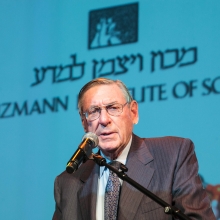Dr. David Gokhman
The human diseases that the great apes never got
New scientists

When it comes to genetic adaptations, humans are unique. Though these adaptations came with advantages like the ability to walk upright and complex brains, they also brought with them many human-specific diseases—Alzheimer’s, schizophrenia, and more.
To understand why these adaptations came at such a high price, Dr. David Gokhman, who recently joined the Department of Molecular Genetics, is searching for the adaptations that set humans apart, by comparing human genes to those of two close relatives—the extinct Neanderthal and Denisovan species, and the great apes.
The DNA sequences of Neanderthals and Denisovans have already been mapped from bone fragments; however, because no tissue cells exist, it is impossible to deduce which genes had been active in the species. Without this data, differences in phenotypes (i.e. their observable characteristics) cannot be explored. The genes of a species rarely change—it is how they are regulated and influence the phenotype that is evolution’s true playground. During his PhD, Dr. Gokhman offered an unprecedented glimpse into ancient gene regulation by using existing Neanderthal and Denisovan DNA sequences to computationally reconstruct a full “DNA methylation map.” Because DNA methylation is one of the main epigenetic processes that controls gene expression, Dr. Gokhman’s map marked a significant leap forward in the study of comparative evolution.
During his postdoctoral studies, Dr. Gokhman compared human adaptations to those of chimpanzees. Because tissue samples exist for both species, reams of biological data could be collected. However, a different problem arose. Since there are many non-evolutionary causes for phenotypic variances, isolating the purely evolutionary changes would be like searching for a needle in a haystack.
Dr. Gokhman’s solution to this problem was unique: to generate human-chimpanzee hybrid cells. Within these cells, he could still distinguish between the human and chimpanzee chromosomes; but now, because both sets of chromosomes were exposed to the same control conditions, he could automatically consider any detectable differences between the two sets of chromosomes to be evolutionary.
In his new lab at the Weizmann Institute, Dr. Gokhman plans to hybridize human cells with those of gorillas and orangutans. He hopes to discover which adaptations originated in humans and which originated in great apes, and bring us one step closer to identifying the mechanisms that underlie human-specific diseases.
Biosketch
Dr. David Gokhman completed his BSc, magna cum laude, in 2011 at the Hebrew University of Jerusalem, with a major in biology and a minor in chemistry. He also earned his MSc (2012) and PhD (2018) degrees in the Department of Genetics at the Hebrew University. He conducted postdoctoral research at Stanford University, and joined the faculty of the Weizmann Institute in 2021.
Dr. Gokhman’s awards and recognitions include the Mochrik Prize for outstanding students in 2014, the Dan David Young Researcher Award in 2017, and the Hans Wiener Prize for best doctoral thesis, in 2018. His research earned the title of “Breakthrough of the Year” both in Archaeology magazine in 2014, and in Science magazine in 2019 (people’s choice). He also made The Marker magazine’s “40 Under 40” list in 2020. Before attending Hebrew University, Dr. Gokhman worked as the head of the data mining team at the Prime Minister’s Office, and was the recipient of the Israel Defense Prize for exceptional technological breakthroughs in 2008.
Dr. Gokhman is married to his husband Asaf.








